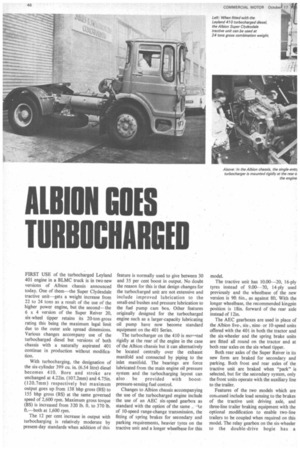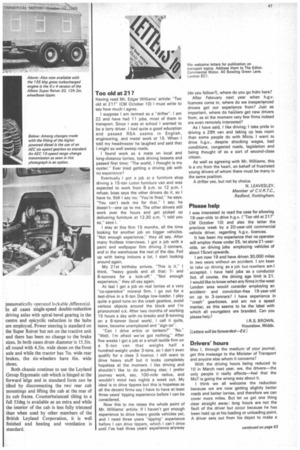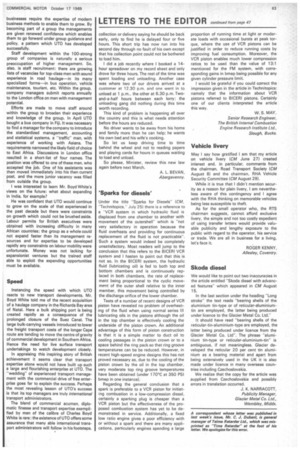ALBION GOES TURBOCHARGED
Page 48

Page 49

Page 65

If you've noticed an error in this article please click here to report it so we can fix it.
FIRST USE of the turbocharged Leyland 401 engine in a BLMC truck is in two new versions of Albion chassis announced today. One of them—the Super Clydesdale tractive unit—gets a weight increase from 22 to 24 tons as a result of the use of the higher power engine, but the second— the 6 x 4 version of the Super Reiver 20, six-wheel tipper retains its 20-ton-gross rating this being the maximum legal limit due to the outer axle spread dimensions. Various changes accompany use of the turbocharged diesel but versions of both chassis with a naturally aspirated 401 continue in production without modification.
With turbocharging, the designation of the six-cylinder 399 cu. in. (6.54 litre) diesel becomes 410. Bore and stroke are unchanged at 4.22in. (107.2mm) and 4.75in. (120.7mm) respectively but maximum output goes up from 138 bhp gross (BS) to 155 bhp gross (BS) at the same governed speed of 2,600 rpm. Maximum gross torque (BS) is increased from 320 lb. ft. to 370 lb. ft.—both at 1,600 rpm.
The 12 per cent increase in output with turbocharging is relatively moderate by present-day standards when addition of this feature is normally used. to give between 30 and 35 per cent boost in output. No doubt the reason for this is that design changes for the turbocharged unit are not extensive and include improved lubrication to the small-end bushes and pressure lubrication to the fuel pump cam box. Other features originally designed for the turbocharged engine such as a larger-capacity lubricating oil pump have now become standard equipment on the 401 Series.
The turbocharger on the 410 is mo,,nted rigidly at the rear of the engine in the case of the Albion chassis but it can alternatively be located centrally over the exhaust manifold and connected by piping to the inlet manifold. The bearings are force lubricated from the main engine oil pressure system and the turbocharging layout can also be provided with boostpressure-sensing fuel control.
Changes to Albion chassis accompanying the use of the turbocharged engine include the use of an AEC six-speed gearbox as standard with the option of the same -ke of 10-speed range-change transmission, the fitting of spring brakes for secondary and parking requirements, heavier tyres on the tractive unit and a longer wheelbase for this model.
The tractive unit has 10.00-20, 16-ply tyres instead of 9.00--20, 14-ply used previously and the wheelbase of the new version is 9ft 6in., as against 8ft. With the longer wheelbase, the recommended kingpin position is 18in. forward of the rear axle instead of I 2in.
The AEC gearboxes are used in place of the Albion five-, six-, nineor 10-speed units offered with the 401 in both the tractor and the six-wheeler and the spring brake units are fitted all round on the tractor and at both rear axles on the six-wheel tipper.
Both rear axles of the Super Reiver in its new form are braked for secondary and parking. Both front and rear axles of the tractive unit are braked when "park" is selected, but for the secondary system, only the front units operate with the auxiliary line to the trailer.
Features of the two models which are conunued include load sensing to the brakes of the tractive unit driving axle, and three-line trailer braking equipment with the optional modification to enable two-line trailers to be coupled when required on this model. The relay gearbox on the six-wheeler to the double-drive bogie has a
pneumatically operated lockable differential. In all cases single-speed double-reduction driving axles with spiral-bevel gearing in the centre and epicyclic reduction in the hubs are employed. Power steering is standard on the Super Reiver but not on the tractive unit and there has been no change to the brake sizes. In both cases drum diameter is 15.5in, all round with 4.5in. wide shoes on the front axle and while the tractor has 7in. wide rear brakes, the six-wheelers have 6in. wide shoes.
Both chassis continue to use the Leyland Group Erg omatic cab which is hinged at the forward edge and in standard form can be tilted by disconnecting the two rear cab mountings and lifting the cab at the rear of its sub frame. Counterbalanced tilting to a full 55deg is available as an extra and while the interior of the cab is less fully trimmed than when used by other members of the British Leyland Corporation, it is well finished and heating and ventilation is standard. Too old at 21?
Having read Mr. Edgar Williams' article: "Too old at 21?" (CM October 10) I must write to say how much I agree.
I suppose I am termed as a "drifter-. I am 22 and have had 11 jobs, most of them in transport. Since I was at school I wanted to be a lorry driver. I had quite a good education and passed RSA exams in English, engineering, and metal work at 15. When I told my headmaster he laughed and said that I might as well sweep roads.
I found work as a mate on local and long-distance lorries, took driving lessons and passed first time; "The world, I thought is my oyster." Ever tried getting a driving job with no experience?
Eventually I got a job at a furniture shop driving a 15-ton Luton furniture van and was expected to work from 8 a.m. to 12 p.m. I refuse; boss says the other drivers do it, so I have to. Still I say no; "You're fired," he says. -You can't sack me for that," I say; he doesn't—one up to me. The other drivers still work over the hours and get picked up delivering furniture at 12.30 a.m. "I told you so," says I.
I stay at this firm 15 months, all the time looking for another job on bigger vehicles. "Not enough experience," they all say. After many fruitless interviews, I got a job with a paint and wallpaper firm driving 2-tonners, and in the warehouse the rest of the day. Fed up with being indoors a lot, I start looking around again.
My 21st birthday arrives. "This is it," I think, "heavy goods and all that; 7and 8-tonners for a kick-off," "Not enough experience," they all say again.
At last I get a job on real lorries at a very "co-operative" mineral firm. I go out for a test-drive in a 6-ton Dodge low-loader. I play quite a good tune on the crash gearbox, avoid various objects around the block and I'm pronounced o.k. After two months of working 15 hours a day with no breaks and 8-tonning on a 6-tonner (local work), I call it quits, leave, become unemployed and -sign on".
"Can I drive artics or tankers?" "No." -Well, I'm afraid we've got nothing." After five weeks I get a job at a small textile firm on a 5-ton van that weighs half a hundred-weight under 3-tons, so I don't even qualify for a class 3 licence. I still want to drive heavy stuff but it looks completely hopeless at the moment. I like driving and shouldn't like to do anything else; I prefer journey work, say, 100-mile radius, and wouldn't mind two nights a week out. My ideal is to drive tippers but this is hopeless as all the decent firms say I have to have at least three years' tipping experience before I can be considered.
Now this to me raises the whole point of Mr. Williams' article. If I haven't got enough experience to drive heavy goods vehicles yet, and I need three years "tipping" experience before I can drive tippers, which I can't drive until I've had three years' experience anyway
(do you follow?), where do you go frdm here?
After February next year when h.g.v. licences come in, where do we inexperienced drivers get our experience from? Just as important, where do hauliers get new drivers from, as at the moment very few firms indeed are even remotely interested?
As I have said, I like driving; I take pride in driving a 23ft van and taking up less room than some people do with Minis, I want to drive h.g.v., despite shocking wages, bad conditions, congested roads, legislation and being thought of as a sort of second-class citizen.
As well as agreeing with Mr. Williams, this is a cry from the heart, on behalf of frustrated young drivers of whom there must be many in the same position.
A drifter yes, but not by choice.
N. LEAVESLEY, Member of C.V.R.T.C., Radford, Nottingham.
Please help
I was interested to read the case for allowing 18-year-olds to drive h.g.v. ("Too old at 21?" CM October 10) and also the letter the previous week by a 20-year-old commercial vehicle driver, regarding h.g.v. licences.
It has been my experience that no operator will employ those under 25, let alone 21-yearolds, on driving jobs employing vehicles of about 15cwt upwards.
I am now 19 and have driven 30,000 miles in two years without an accident. I am keen to take up driving as a lob but nowhere am I accepted. I have held jobs as a conductor but, of course, the driving age limit is 21. I would like to know when any firms in the west London area would consider employing an accidentand conviction-free 19-year-old on up to 3-tonners? I have experience in "crash" gearboxes, and am not a speed maniac, as this seems to be the label with which all youngsters are branded. Can you please help?
I.R.S. BROWN, Hounslow, Middx.
[Letters wi//be forwarded—Ed.]
Drivers hours
May I, through the medium of your journal, get this message to the Minister of Transport and anyone else whom it concerns?
With the driving hours being reduced to 10 in March next year, we, the drivers—the only people it really affects—feel that the MoT is going the wrong way about it.
I think we all welcome the reduction because we are now getting slightly better roads and better lorries, and therefore we can cover more miles. But let us get one thing clear straight away; long hours are not the fault of the driver but occur because he has been held up at his loading or unloading point. A driver sets out from his depot to make a collection or delivery saying he should be back early, only to find he is delayed four or five hours. This short trip has now run into his second day through no fault of his own except that his collection point could not be bothered to load him.
I did a job recently where I booked a 14hour spreadover on my record sheet and only drove for three hours. The rest of the time was spent loading and unloading. Another case was where two of our drivers arrived at a customer at 12.30 p.m, and one went in to unload at 1 p.m., the other at 6.30 p.m. Twoand-a-half hours between each lorry: the unloading gang did nothing during this time worth recording.
This kind of problem is happening all over the country and this is what needs attention before the hours are reduced.
No driver wants to be away from his home and family more than he can help: he wants his own bed and his wife's cooking.
So let us keep driving time to time behind the wheel and not to reading papers and playing cards for hours in queues waiting to load and unload.
So please, Minister, review this new law again before next March.
A. L. BEVAN, Abergavenny.
'Sparks for diesels'
Under the title "Sparks for Diesels" (CM, "Technitopics." July 251 there is a reference to a "VCR system in which hydraulic fluid is displaced from one chamber to another with movement of the outershell" which is "not very satisfactory in operation because the fluid overheats and providing for continuous replacement of the fluid is not practicable". Such a system would indeed be completely unsatisfactory. Most readers will jump to the conclusion that this refers to the BICERI VCR system and I hasten to point out that this is not so. In the BICERI system, the hydraulic fluid Ilubricating oil) is fed to both top and bottom chambers and is continuously replaced in both chambers, the rate of replacement being proportional to the cyclic movement of the outer shell relative to the inner member, this movement being controlled by the discharge orifice of the lower chamber.
Tests of a number of recent designs of VCR piston have revealed no problem of overheating of the fluid when using normal series III lubricating oils in the pistons although the oil in the top chamber is effectively cooling the underside of the piston crown. An additional advantage of this form of piston construction is that it is a simple matter to duct oil to cooling passages in the piston crown or to a space behind the ring pack so that ring groove temperatures can be be reduced. However, in recent high-speed engine designs this has not proved necessary as, due to the cooling of the piston crown by the oil in the top chamber, very moderate top ring groove temperatures have been obtained (under 170°C at 350 PSI bmep in one instance).
Regarding the general conclusion that a spark is preferable to a VCR piston for initiating combustion in a low-compression diesel, certainly a sparking plug is cheaper than a VCR piston but the effectiveness of the proposed combustion system has yet to be demonstrated in service. Additionally, a fixed low ratio engine gives a poor efficiency with or without a spark and there are many applications, particularly engines spending a large proportion of running time at light or moderate loads with occasional bursts at peak torque, where the use of VCR pistons can be justified in order to reduce running costs by improving fuel consumption. Moreover, the VCR piston enables much lower compression ratios to be used than the value of 13:1 mentioned for the FM system, with corresponding gains in bmep being possible for any given cylinder pressure limit.
I would be grateful if you could correct the impression given in the article in Technitopics: namely that the information about VCR pistons referred to BICERI pistons. Certainly one of our clients interpreted the article this way.
W. S. MAY, Senior Research Engineer, The British Internal Combustion Engine Research Institute Ltd.. Slough, Bucks.
Vehicle livery
May I say how gratified I am that my article on vehicle livery (CM June 271 created interest and, in particular. comments from the chairman, Road Transport Society (CM August 8) and the chairman, R HA Vehicle Security Committee (CM August 29).
While it is true that I didn't mention security as a reason for plain livery, I am nevertheless aware of this contingency and I agree with the R HA thinking on memorable vehicles being less susceptible to theft.
As for the small operator who, the RTS chairman suggests, cannot afford exclusive livery, the simple and not too costly expedient of using transfer letters would provide valuable publicity and lengthy exposure to the public with regard to the operator, his service or trade. We are all in business for a living, let's face it.
ROGER KENNY. Allesley, Coventry.
Skoda diesel
We would like to point out two inaccuracies in the article entitled "Skoda diesel with advanced features" which appeared in CM August 15.
In the last section under the heading "Long stroke" the text reads "bearing shells of the aluminium tin-type or of reticular-aluminiumtin are employed, the latter being produced under licence to the Glacier Metal Co. Ltd."
It should have read "bearing shells of the reticular-tin-aluminium-type are employed, the latter being produced under licence from the Glacier Metal Co. Ltd". The phrase "aluminium tin-type or reticular-aluminium-tin" is ambiguous, if not meaningless. Glacier developed the reticular 20 per cent tin aluminium as a bearing material and apart from being extensively used in the UK it is also made under licence in many overseas countries including Czechoslovakia.
We realize that the copy for the article was supplied from Czechoslovakia and possibly errors in translation occurred.
J. K. NARRACOTT, Publicity Manager, Glacier Metal Co. Ltd., Wembley, Middx.




























































































































